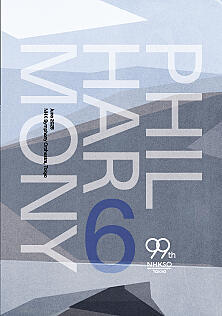- Home
- Concerts
- Subscription Concerts 2024-2025
- Program C
- No. 2041 Subscription (Program C)
Subscription Concerts 2024-2025Program C
No. 2041 Subscription (Program C)

Program
Korngold / Violin Concerto D Major Op. 35
Erich Wolfgang Korngold (1897–1957) enjoyed exceedingly smooth sailing earlier in life as a composer, in contrast to his later years which took an unexpected turn. Born as a child of the renowned music critic Julius Korngold in Brünn (today Brno), Austria-Hungary, he soon moved to Vienna. Gustav Mahler (Julius’s friend) famously praised Korngold’s cantata calling the nine-year-old composer a genius. His fame continued to grow in Europe until the rise of Hitler and the outbreak of World War II caused an unprecedented number of Jewish people to expatriate including Korngold. In the USA, his new base, he wrote scores for many American movies. His style, featuring Wagnerian leitmotif technique and Mahlerian/R. Straussian orchestration pioneered the Hollywood music we hear today.
Written in D major as with Beethoven’s and Tchaikovsky’s, Korngold’s Violin Concerto (1945) dates from this American period and it was premiered after the war in 1947 in the USA. The Viennese premiere of the same year got harsh feedback which greatly disappointed Korngold: he was, for Europeans, an outdated late-Romantic who now served popular entertainment. This Concerto quoting four of Korngold’s movie scores, however, reminds modern-day people’s ears of how skillfully refined and appealing his film music was.
The first movement headed “nobile (nobly)” is in a flexible sonata form. At the start, the violin solo immediately states the broad principal theme based on Korngold’s score for the movie Another Down (1937). The beginning (A–D–A–D–G♯) of this theme will recur to unify the whole concerto. During the central A-major section, the violin solo sings another ear-pleasing melody from his music for the movie Juarez (1939). The slow second movement in G major, Romance, is in ABA form. The gentle main theme given by the violin solo is from the score for the movie Anthony Adverse (1936) which brought Korngold the Academy Award for Best Music. The virtuosic finale in rondo-sonata form in D major also recalls the trailblazer of the Hollywood music: the melodious second theme introduced in B♭ major by the violin solo is from Korngold’s score for the movie The Prince and Pauper (1937).
[Kumiko Nishi]
Mahler / Symphony No. 1 D Major, Titan
Born in Kalischt, Bohemia (in the Austrian Empire) in 1860—merely two years earlier than Claude Debussy (1862–1918)—, Gustav Mahler (1860–1911) is considered the last Romantic titan. His style is influenced by Wagner when it comes to rich harmonies, extreme chromaticism and long-stretched melodies. And all of Mahler’s symphonic works are the epitome of late-Romanticism with their highly expressive and reflective nature, great length and colossal formation.
Completed in 1888 in his late twenties while he was the Leipzig Opera’s second conductor in Germany, Mahler’s Symphony No. 1 already shows several signature features that will be present in his later symphonies, the prime examples being the sublime and the profane sitting side by side, evocations of Nature, and pregnant citations of his own songs. Interestingly enough, No. 1 was conceived and first performed (in Budapest in 1889) as a symphonic poem with five movements in two parts. Then Mahler, a tenacious reviser, entitled the 1893 Hamburg version “Titan, a tone-poem in symphony form” after Jean Paul’s four-volume novel Titan (1803) giving programmatic titles to the parts and movements which allude to Jean Paul, E. T. A. Hoffman and Dante. Although Mahler affirmed later these titles were afterthoughts and misleading, they continue to stimulate the imagination of the interpreters and listeners of this titanic work to a greater or lesser extent.
Commonly performed today as the Symphony No. 1 is the 1896 Berlin version. (Mahler would keep making minor revisions to it.) Distinctive differences between this version and the former ones are that it is in four movements (the bipartite concept was dropped and the slow movement “Blumine” was cut out entirely), has no descriptive titles, and calls for a larger orchestra including at least seven horns and two sets of timpani.
The first movement is a sonata with a slow extended introduction which illustrates, according to the Hamburg version, “the awakening of Nature from the long sleep of winter.” The woodwinds introduce a falling fourth-interval motif (soon turning to cuckoo calls) which will recur as a unifying element of the entire symphony. The second movement is a Ländler, a Bavarian and Austrian rural dance. The main theme is a quotation from Mahler’s own song Hans and Grete that he originally wrote as May Dance on the Green for his first love in 1880.
Ironically cheery, the third movement is an early example of Mahler’s obsession with the funeral march. Over timpani, the contrabass solo first sings the nursery round tune Bruder Martin (also known as Bruder Jacob or Frère Jacques) eerily in a minor key. Without a pause, a cymbal crash begins the finale that the Hamburg version called “Dall’inferno (From Hell), the suddenly erupting cry of a heart wounded to its depths.” After the comeback of the symphony’s opening introduction, Mahler lets seven hornists stand to play during the triumphant ending.
[Kumiko Nishi]
Artists
 ConductorTarmo Peltokoski
ConductorTarmo Peltokoski
Can you imagine a conductor who was born in 2000? Moreover a young conductor who enjoys multiple positions with orchestras in many parts of the world. The Finnish conductor Tarmo Peltokoski studied under Jorma Panula at the age of fourteen, continued studies under Sakari Oramo at the Sibelius Academy, and then went under the tutelage of Hannu Lintu, Jukka-Pekka Saraste, and Esa-Pekka Salonen. He jumped into the limelight in January 2022 when he was appointed as Principal Guest Conductor of The Deutsche Kammerphilharmonie Bremen, then he continued to make headlines by being appointed as Music Director and Artistic Director of the Latvian National Symphony Orchestra in May the same year, Principal Guest Conductor of the Rotterdam Philharmonic Orchestra in September, then in December, Music Director of the Orchestre National du Capitole de Toulouse. It is virtually unprecedented for a conductor to have built such an international career in such a short span of time. Furthermore, he will assume the position of Music Director of the Hong Kong Philharmonic Orchestra in the 2026–27 season. In the operatic field, he has built up his career by conducting Wagner’s complete cycle of Der Ring des Nibelungen at the Eurajoki Bel Canto Festival.
As for recordings, he released a collection of three symphonies of Mozart with The Deutsche Kammerphilharmonie Bremen from a prestigious label. In addition to his bold and innovative interpretations, he has aroused public attention by inserting his own piano improvisations between the works on the streaming.
He also actively works on Mahler, therefore, it is our pleasure to see what kind of sound he will draw out from the NHK Symphony Orchestra.
[Yoichi Iio, music journalist]
 ViolinDaniel Lozakovich
ViolinDaniel Lozakovich
Born in Stockholm in 2001, Daniel Lozakovich started to learn violin at the age of six, and two years after that, he had already made his concert debut playing a concerto with the Moscow Virtuosi conducted by Vladimir Spivakov. His concerts have always been received with high acclaim, and Le Figaro, the French newspaper, praised his concert as “Perfect mastery. An exceptional talent.” Having been highly impressed by his talent, virtuoso violinist, Ivry Gitlis, invited him to Tel Aviv to perform Bach’s Concerto for Two Violins together in a festival.
Lozakovich studied at Universität für Musik und darstellende Kunst Wien with Professor Dora Schwarzberg and at the Hochschule für Musik Karlsruhe with Josef Rissin. He has already worked with world’s major orchestras, and signed an exclusive contract with a long-established German record label in 2016, becoming the company’s youngest artist under an exclusive contract. This is going to be his first appearance with the NHK Symphony Orchestra, performing Violin Concerto, a masterpiece by Korngold, a gifted composer who was popular in the United States. Lozakovich is expected to delight his audience with his beautiful sound and superb technique.
[Takuya Katagiri, music critic]
Download
Ticket
Program C
No. 2041 Subscription (Program C)
NHK Hall
Google Map
Seating Chart
Single Tickets Release Date
Pre-sales for Subscribers:Wednesday, February 26, 2025
*about subscribers
Sale to General Public:Sunday, March 2, 2025
Price
| S | A | B | C | D | E | |
|---|---|---|---|---|---|---|
| Ordinary Ticket | 10,000 | 8,500 | 6,500 | 5,400 | 4,300 | 2,200 |
| Youth Ticket | 5,000 | 4,000 | 3,100 | 2,550 | 1,500 | 1,000 |
Seating chart Enlarge Print PDF
*tax included
*Subscribers receive a 10% discount (Available at NHKSO WEB Ticket and N-Kyo Guide)
*For wheelchair-accessible seats, please refer to the N-Kyo Guide
Youth Tickets
Youth Tickets are great options for those of 29 years old and younger
Subscription tickets
Release Date
ANNUAL SUBSCRIPTION TICKETS
Mon., July 15, 2024 10:00am
[For Subscribers: Sun., July 7, 2024 10:00am]
SEASONAL SUBSCRIPTION TICKETS (SPRING)
Wed., February 19, 2025 10:00am
[For Subscribers: Thu., February 13, 2025 10:00am]
Where to buy
NHKSO WEB Ticket | Friday, June 20, 2025 (In English / Seats not selectable)
NHKSO WEB Ticket | Saturday, June 21, 2025 (In English / Seats not selectable)
NHKSO WEB Ticket (In Japanese only / Seats selectable)
N-Kyo Guide (Purchase by telephone only)
Other Ticket Agents
*Repertoire, conductor, soloists and program order are subject to change without notice.
*Pre-school children are not allowed in the concert hall


